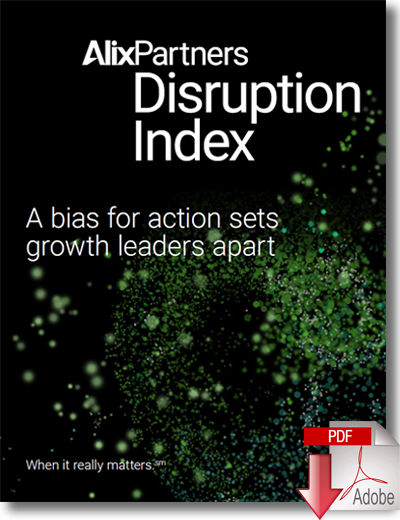The Elusive AI Based Supply Chain Control Tower Platform

Looking at how a supply chain control tower responds to disruption is a useful illustration of why “practical digital” deployed with a comprehensive operating model is so critical, to make control towers work, additionally, organizations must teach themselves to think differently and potentially evolve how critical decisions are made across their businesses.
Supply Chains Need Control Towers
The capability to track components, work-in-progress, and finished goods in detail and in real-time, to spot problems fast so they can be fixed fast, and to monitor costs and payments along with physical goods using an ai-based supply chain control tower platform.
The COVID supply chain crisis acted like a stress test, revealing many structural problems in supply chains. Executives learned that they had less visibility, less real-time information, and less resilience in their supply chains than they had thought.
AlixPartners Disruption Index found that today eight out of ten say they need to diversify their supply base; similar numbers say they need to invest in AI solutions to combat supply chain disruptions, and three in five worries that supply chain disruption will put them so far behind their competition that they can’t catch up.
A big insight from the crisis is that supply chains need control towers - the capability to track components, work-in-progress, and finished goods in detail and in real-time, to spot problems fast so they can be fixed fast, and to monitor costs and payments along with physical goods. The design of a control tower will vary according to the configuration of a company’s supply chain, but a conceptual view of a multi-national product flow is shown below:
Control Tower | Conceptual Diagram of End-to-End Execution Management
![]()
Complex trade flows can contain multiple distribution nodes serviced by various logistics partners and modes, making it extremely challenging to deliver a seamless execution. Companies that were able to react in real-time to disruptive events through a supply chain control tower fared much better than those with less sophisticated visibility tools.
But they can also waste money. Control towers - and the supply chains they oversee - need to be built on the principle of “practical digital,” to ensure that the technology is aimed at the right business questions and is producing insights companies can act on. That means their operating model needs to consider more than the tools. Companies need to have the right people because even the best digital capabilities cannot have conversations with important customers when problems arise. They need the right processes, including a process to override automated functions to manage exceptions with purpose. They need appropriate fiduciary controls (inventory, billing, invoicing, receivables, cash application, etc.). And, because digital is only as good as its data, companies need data governance capabilities and accurate customer mapping.
To make control towers work, organizations must teach themselves to think differently and potentially evolve how critical decisions are made across their businesses, which adds an element of governance to the process. Looking at how a supply chain responds to disruption is a useful illustration of why “practical digital” deployed with a comprehensive operating model is so critical.
Control tower use Case: Give me Options! (When “No” will not suffice…)
Despite the best intentions and risk management planning, the pandemic forced many companies to refuse orders from important and strategic customers. In normal times, a backorder is followed with estimates of product availability along with viable product substitutions. However, the broad category-wide shortages of 2020-2021 made these estimates inaccurate, and often there simply were not any short-term viable alternatives to offer.
Unfortunately, that did not make telling your most important customers “NO” any more acceptable. Complicating matters, many contingency plans address discrete one-time crises and do not provide options that deal with a prolonged pandemic and its broad supply chain impact.
In response, cross-functional teams were formed and charged with working through complex supply situations to mitigate difficult priorities on a real-time basis. In a sense, these teams were asked to create a supply chain control tower under a fast-track, and at times ad-hoc, mandate. For many companies, this was another illustration of the need for a coordinated operating model built upon people, processes, and digital technology.
People capability: In a crisis, decision-making is often escalated and centralized. (Think of the “Situation Room” in a national security context.) Those protocols need to be reexamined; the long-term operating model for a control tower is likely to need more flexibility and more empowerment so that decisions can be made at the appropriate level of the organization, and, of course, the ability to escalate problems and decisions where necessary.
Process capability: How easily did your organization fast-track the development of alternative supply chain processes? Can your product and supplier qualification processes evolve quickly enough to take advantage of new options? Or will the option disappear before your organization can act? Are you comfortable with the risk that a fast track might entail (product quality, credit, customer acceptance)? The stakes can be high: slow or risk-averse players may be pushed to the back of the line by faster competitors. But those with the means to make large commitments may do so with imperfect information and may find themselves stuck with unwanted consequences.
Digital technology: Does this quote sound familiar? “I’m not sure this data is 100% correct… Does this report include yesterday’s production?... Until we have the correct information, we need to postpone this decision…” Sentiments like these reflect a lack of confidence in the information that is presented by the digital solution. Often the problem is not the tools, but the data they’re given to work with and its relevance to the business problem to be solved. Do you have accurate customer mapping into segment priorities for allocation? Are segment definitions in line with how your organization wants to prioritize resources? Decision support tools must be fast, up-to-date, trusted, and relevant to be a viable component of a control tower operating model.
Build your Control Tower on a Comprehensive Operating Model
A control tower can transform supply change management, creating a digital supply chain that is faster, cheaper, and more resilient than the old one. To do that, the control tower needs to be built with a complete operating model for the new digital supply chain. This model must include people, processes, and digital technology. The digital technology portion of the model may be the easiest one to implement (If sound data governance structures are in place). The people and process elements will be the key differentiators of a solution that creates lasting value.
Article Topics
AlixPartners News & Resources
Companies Shifting Away from China a Boon to U.S., Mexico U.S and Mexico are pegged to be big winners as companies move away from China 5 Tips to Help Your Supply Chain Navigate Panama Canal Restrictions The nearshoring revolution is just beginning, says AlixPartners’ report The Elusive AI Based Supply Chain Control Tower Platform AlixPartners 2023 Disruption Index A Bias for Action Sets Growth Leaders Apart 2023 Container Shipping Outlook: This Time is Different More AlixPartnersLatest in Supply Chain
TIm Cook Says Apple Plans to Increase Investments in Vietnam Amazon Logistics’ Growth Shakes Up Shipping Industry in 2023 Spotlight Startup: Cart.com is Reimagining Logistics Walmart and Swisslog Expand Partnership with New Texas Facility Nissan Channels Tesla With Its Latest Manufacturing Process Taking Stock of Today’s Robotics Market and What the Future Holds U.S. Manufacturing Gains Momentum After Another Strong Month More Supply ChainWelcome to the Age of Disruption.
In this, the 4th annual AlixPartners Disruption Index, we surveyed 3,000 business executives and delve deeper into the changing nature of the global economy and what business leaders must do to adapt to and take advantage of these shifts. One thing is clear: Those leaders who say they are driving change in the face of disruption are behaving differently.
With the AlixPartners Disruption Index, we hope to provide more perspective on these challenges and, most importantly, greater insight into what best-in-class leaders are doing to meet them.
Read and download the report here: https://alix.click/3FAqSRc


















